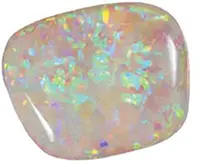
Uncovering the Origins
Opal is an iridescent mineral of hydrated silica, displaying a stunning array of colors like blue, cherry, chrysopal, fire, green, and hyalite. Famous deposits are found in Australia, making it the national gemstone, but it also occurs in the United States, Honduras, Brazil, and Slovakia. NASA’s discovery of opal on Mars in 2008 suggested the presence of liquid water much later than previously thought.
Historical Significance and Lore
Opal is deeply rooted in Australian Aboriginal mythology, believed to be created from the rainbow’s touch to Earth, symbolizing peace and vibrancy. It also features in Sir Walter Scott’s novel, Anne of Geierstein, highlighting its captivating and ever-changing hues.
Healing Properties
Opal is known for its cleansing effects on the body, combating infections and purifying blood. Cherry opal specifically aids in treating blood disorders. Fire opal resonates with the abdomen and lower back, aiding the intestines and kidneys, while green opal bolsters the immune system. Hyalite, or water opal, is effective in treating dehydration.
Magical Uses
A stone of cosmic consciousness, opal induces psychic and mystical visions and reveals emotional insights from past lives. Blue opal is particularly effective in integrating these past experiences into the present.
Feng Shui Applications
In Feng Shui, opal generally embodies water energy, ideal for the northern area and Career/Path in Life sector. Fire opal, with its fiery energy, is best placed in the southern area or the Fame/Reputation sector, symbolizing heat, action, and passion.
Personal and Spiritual Growth
As October’s birthstone, opal is particularly beneficial for artists by stimulating creativity and originality. Chrysopal enhances open-mindedness and vision, fire opal aids in business and justice matters, and green opal improves relationships, catering to a wide range of personal and spiritual needs.
